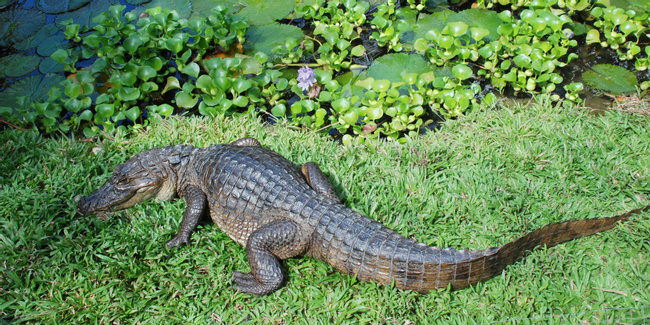
More about Caiman
Habitat
This small crocodilian lives in humid tropic lowlands within rivers, streams, canals, marshes, and swamps. It can also live in water near the ocean. The caiman is more common in areas with high rainfall.
Range
This reptilian species can be found from Tehuantepec, Mexico to central Brazil; it has been introduced to southern Florida, Puerto Rico, and Isla de la Juventud off the coast of Cuba.
Physical Description
This species is much smaller than the American Crocodile (Crocodylus acutus), and is not a threat to humans. In addition to size, a distinguishing trait is the bony ridge between and in front of the eyes, resembling spectacles, granting its common name. Also, on the American Crocodile the fourth tooth on either side of the lower jaw conspicuously sticks out when the croc closes its mouth. The caiman’s teeth are concealed. The caiman is generally a light tan to yellow or brown color with vaguely dark crossbands on the body and tail. Younger caiman are lighter and have more distinct crossbands. For its whole life the belly is a cream to white color and the eyes are gold.
Biology and Natural History
This crocodilian keeps to slow water with a muddy floor. During the day it will swim or bask on soft sandbanks or logs. It hunts at night and is easier to find in the dark with a flashlight. It can also be seen more readily in the dry season when receding water levels restrict more individuals to lower areas.
A mother caiman will lay 15 to 40 eggs in a nest of plant materials that is close to water. She tends to the nest for the next 73 to 90 days. Within the egg, the sex of the caiman is controlled by incubation temperature, known as temperature-dependent sex determination. Meanwhile, parents stay near the nest to ward off egg predators (particularly raccoons) with growling, hissing, and lashing at the water with tail and head. When the babies are ready to hatch, they may scream from within their eggs, calling the mother to open the nest and help the hatchlings to water. She will care for and protect them over the next four months, guarding them from large waterbirds. Adults are only vulnerable to anacondas, large wild cats, and humans.
The illegal market for crocodile and caiman skins was active up until the early 1980s. Thousands of caimans were killed for their skin, and babies were sold alive for the pet trade or killed and mounted.
Diet
The Spectacled Caiman forages more or less opportunistically, eating all animals that are in its habitat. Juveniles mostly eat insects and crustaceans, but larger adults consume fish, amphibians, birds, and corpses of birds or mammals that they find.
Height/Weight
Hatchlings are only 20 to 25 cm (8 to 10 in) from snout to vent and weight 35 to 49 g, but adult caimans are generally 1.25 to 2.5 m (4 to 8 ft) long. Females tend to be somewhat smaller than males. Adult males can weigh as much as 65 kg.
Taxonomy
Order: Crocodilia
Family: Crocodylidae
Sources
Savage, Jay M. The Amphibians and Reptiles of Costa Rica: A Herpetofauna between two Continents, between Two Seas. The University of Chicago Press, Chicago, 2002.
Leenders, Twan. A Guide to Amphibians and Reptiles of Costa Rica. Zona Tropical, S.A, Miami, FL, 2001.
Scott, N. J., J. M. Savage, and D. C. Robinson in: Janzen, Daniel H. Costa Rican Natural History. Chicago: University of Chicago Press, 1983.
-Amy Strieter, Wildlife Writer
Caiman Sightings
Similar Profiles
We believe travel is more than ticking destinations off a list – it’s about discovering new places deeply, feeling connected wherever you go, and knowing you have a trusted team behind you every step of the way.



